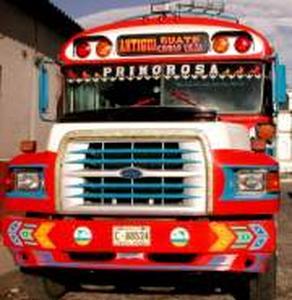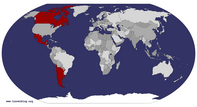Advertisement
Published: March 11th 2005

 Chicken Bus
Chicken Bus
Ahh, the memoriesHaving been back in Guatemala for a week and a half now, and having reacquainted myself with the vagaries of long distance public transport, I feel it is now appropriate to present to you my
Guide to Guatemalan Bus Travel
or
Riding the Gallo
But first, a word on etymology (or is that bugs?). The standard form of travel in Guatemala has been named, by gringos, the chicken bus. For those of us who grew up in Quebec, riding the chicken bus brings back fond memories of childhood, for the buses here in use are, in fact, the Blue Bird Body Co. school buses ubiquitous in Quebec in the 70s and 80s. I can only assume that each of these venerable vehicles, when it had reached the point where it was no longer deemed adequately safe to be entrusted with the lives "de nos petits angeles," was shipped off, perhaps as a charitable write-off, to this country, where the lives entrusted to it would be considerably less "chere."
At any rate, returning toetymology, the term "chicken bus" apparently refers to the chickens that can apparently be found riding the bus with you. I, personally, have never encountered a chicken, fowl, or any other kind of fauna, wild or domesticated, on a bus in Guatemala. At least not inside the bus. In other parts of the world I have had the pleasure to ride in chicken vehicles of every description, not to mention fish camionetas, goose pickups, goat collectivos, Old Macdonald's open air coach service, and of course infamous urinating pig truck. But in Guatemala, in my experience, livestock has been relegated to the roof.
I am forced to conclude, then, that the nomenclature "chicken bus" hearkens back to a happier, more innocent era in the history of Guatemalan transport, when farmers were at liberty to travel with their little friends, before this age of interspecial apartheid.
On then, to your primer on negotiating the chicken bus network.
Finding your terminal
There are actually three cases, three situation you might find yourself in. First, you might be in a town with just one large bus terminal. In this case, your task is relatively simple: go to that terminal. It will probably be in a large dusty field near a market. In all likelihood, it will be marked on a map, or you will have seen it in your wanderings, or at worst you can just follow the concentration of buses.
Second, you might be in the middle of nowhere, a one-horse town with no streets other than the highway running through it. Again, in this case, your solution is simple: go and stand on the side of the highway/dirt road/jungle track that passes for Main Street.
In the third situation, your task is someone less simple. For reasons that have never been made clear, many towns throughout the Central American peninsula have not one terminal, not two, but as many as there are bus companies. If you are lucky, these terminals will be in the same neighbourhood. If not, they will be scattered all over the map. Some companies have buses to some places, others to others, and you obviously have to find the right one.
So, to begin then: before leaving your hotel/bungalow/shack, ask the person at the frontdesk/woman doing the laundry/child chasing chickens around the yard where you might encounter a bus to your destination. Listen carefully to the response, as this might be your best crack at it. The directions will invariably be infuriatingly vague, but you will be assured that it is really quite simple. Don't bother asking for an address: the person you are talking to has lived here all his life, he doesn't need silly things like street names to around and therefore he doesn't know them. You will end up with instructions along the lines of "Go over there to the square, then a little bit passed. Go down the hill to your right and it is right there."
Now by the time you get to the square, down the hill will turn out to be your left, and there will be any number of streets to pick from. Pick one for the hell of it, and trudge in the scorching sun in that direction until you are reasonably sure it can't be this far, then go another five minutes. Stop and ask a shop keeper for directions, just for a laugh. This person, whether or not they have heard of your destination or know where any buses to anywhere can be found, will rattle off directions with extreme confidence, probably telling you to go back the way you came. Follow his directions, for lack of anything better to do.
If, in your wanderings, you happen to stumble on a bus terminal, it will probably not be the one you need. Never fear, though, you can ask somebody inside. He will first assure you that the last bus to your destination has left, and try to convince you to go somewhere else. If you are not yet so frustrated that you are willing to go anywhere just to get out of here, then stick to your guns. After intimating in a hurt voice that if you don't believe him and want to see for yourself, he may give you fresh directions to the terminal you want.
Of course, he's the competition so his directions are even less likely to be helpful. Follow them, again for lack of anything better to do.
Continue the above sequence until you have visited every terminal in town, most twice. By now you will be on the verge of sunstroke. Collapse at the side of the road, fighting back tears of frustration. At around this point, a bus will roll up, a young lad hollering the name of your destination at the top of his lungs. Mission accomplished.
Advanced exercise: Don't even bother looking for a bus terminal. Pick a busy streetcorner and sit down. Wait for your bus to drive by. After sunset, return to your hotel. Sleep. Wake up. Repeat.
Finding your bus
If you are in one of the towns with just one big terminal, or if you are in one of the towns with many terminals and by some miracle have found the correct one, this will in fact be surprisingly easy. At the sight of a gringo with a backpack, half a dozen men who appear to be passed out from the heat will jump up and start crying out destinations to you, along with a few phrases such as "Where you go?" Grunt the name of your destination, they will lead you through a maze of buses unfailingly arriving at the correct one for your destination. They may even carry your bag for you. To this day I have no idea what motivates these men to be so helpful. They never ask for a dime, and there is no evidence of a transaction between them and the bus driver.
If, on the other hand, you are standing by the side of the road in the middle of nowhere, attempt to flag down every passing bus. Half will pass you by without a glance. Another half will slowdown enough for you to read the destination on the front; if it is yours, wave more frantically. The rest will stop (well, slow down really) and before you have time to ask anything, they will have thrown your packs on the roof and hustled you on. Sit down and hope you're going in the right direction.
Choosing a seat
This may be the finest and most nuanced art of riding the chicken bus. There are many factors to consider. The suspensions and roads being what they are, sitting at the back of the bus will be bone rattling. On the other hand, the extreme preference for the front of the bus on the part of wide Mayan women and their large broods of children means that they will often sit three abreast (this is not counting children, who go between the legs or on the laps of anybody nearby) in the front when there are still completely empy benches in the back. Furthermore, in the front you will be squeezed throughout the trip by people trying to get in and out of the bus using an aisle that is already occupied by the third person on each bench (one cheek on the bench, one hanging in mid-air, held up only because shoulder to shoulder with the person across the "aisle").
The only thing that can be said with certainty on this subject is do not, under any circumstances, sit over the wheel well.
Now, having chosen your row, the next dilemma is which of the "three" positions on the bench to choose. Do not be lulled into complacency on a relatively empty bus thinking you will have the whole bench to yourself. More people will inevitably be getting on - you need to consider your strategy for when they do. Do you want to sit by the window? This has the advantage that you can look out at the scenery, and sometimes more crucially fix your eyes on the horizon to fend off nausea. However, recall that these benches were built for 5 to 14 year olds, and your fellow passengers are 5' 5'' or less. When squeezed in three to a seat, you will be licking your knees.
You could choose the middle seat, on the basis that it will be an aisle seat for some time at least, depending on how effectively you scowl at boarding passengers. Finally, and this is not an option I would recommend when any alternative is available, you may choose to be third man in and perch with one cheek on the edge of the bench, trying not to have your spine twisted into a pretzel as you hang on around hairpin turns.
Advanced exercise: Ride standing up. On a crowded bus, this may be the most comfortable option. Perch your ass on the back of a seat, probably on somebody's shoulder. Reach up with your hands to the white-knuckle bars running the length of the roof. Rest your head on your forearms. Truly advanced riders may attempt sleeping in this position.
Stay tuned for the next installment, where we will cover Hanging On and Defending Your Space.
Advertisement
Tot: 0.131s; Tpl: 0.011s; cc: 11; qc: 46; dbt: 0.0839s; 1; m:domysql w:travelblog (10.17.0.13); sld: 1;
; mem: 1.1mb








